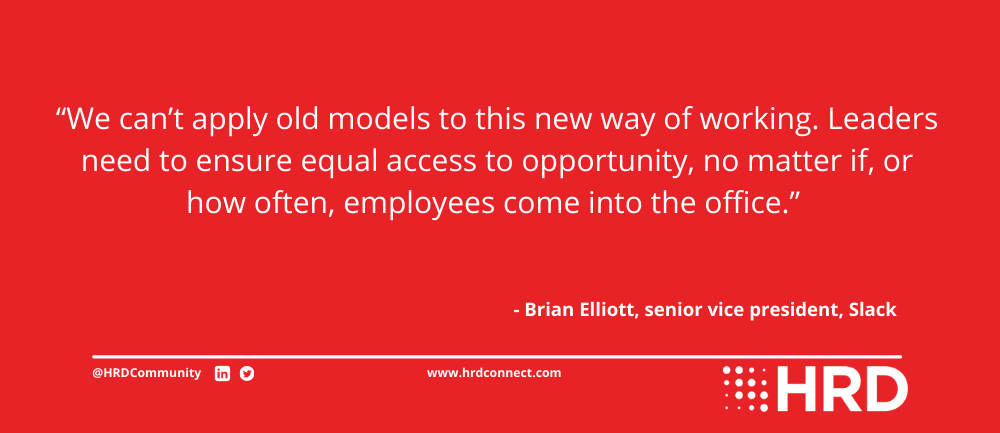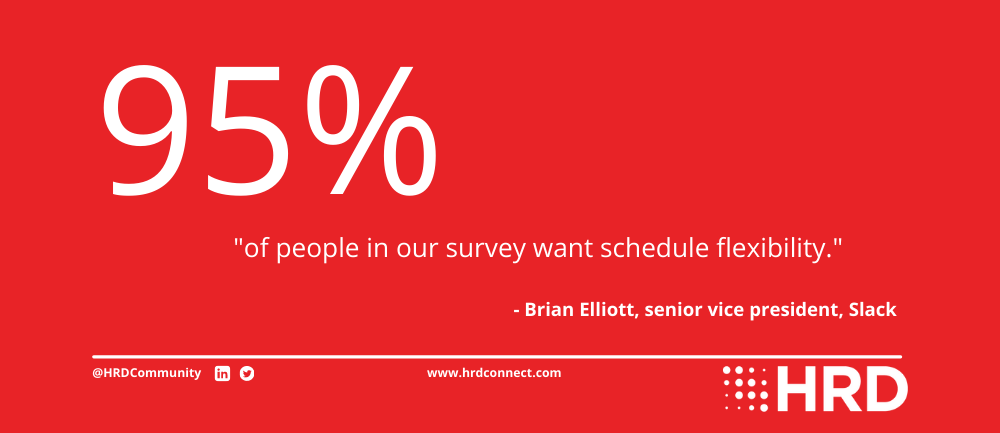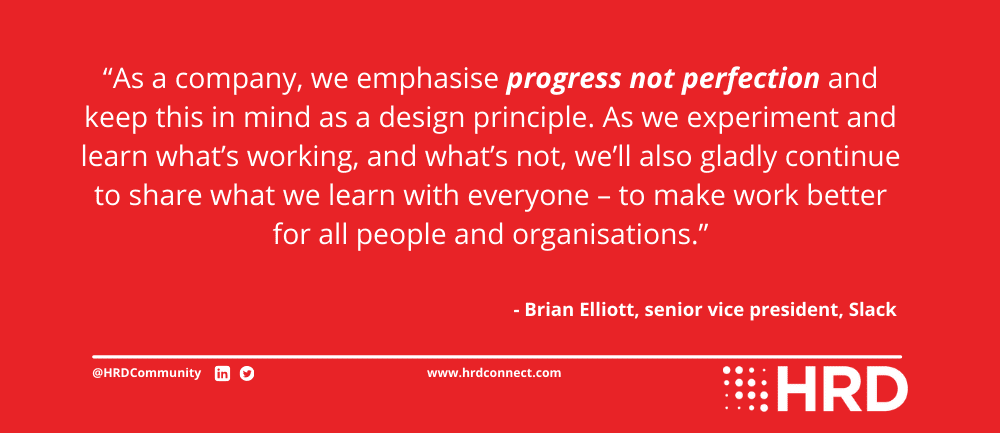-
Provided by

- Date published: Apr 19, 2022
- Categories
Hybrid working is fair, right?
According to its many advocates, hybrid is the ideal blend of presencial and remote working. Of the old guard and the new breed, the physical and the digital.
But there’s a growing body of evidence to suggest that, if hybrid isn’t applied properly, it can actually be extremely unfair. Far from giving everyone their ideal version of work, it can create a two-speed corporate environment in which remoters are punished for their personal choice.
Proximity bias is becoming ever more of a (virtual) watercooler topic among the HR community. Leaders worry that those who rush back to the office will gain privileges or preferential treatment at the expense of their remote counterparts. Some research even suggests this will create silence discrimination, punishing traditional minority groups for their inability to go ‘back to work’.

Slack’s research on this topic is particularly troubling. Based on surveys in America, the San Francisco-headquartered tech giant reports that a greater percentage of black, hispanic and Asian-American workers are choosing to work away from the office than white workers. Women are more likely to work remotely than men, and working parents value location flexibility more than non-parents.
Brian Elliott is one of the main architects of this research. As well as being a senior vice-president at Slack, he is executive leader of the company’s Future Forum, which publishes surveys of over 10,000 knowledge workers every quarter. And based on his research, he believes hybrid cannot be truly fair unless it actively seeks to accommodate everyone.
“Without active leadership and investment, hybrid can be the “messy middle” of work models,” Brian says. “Challenges such as proximity bias come up because certain employee groups, executives, men, white knowledge workers, non-parents, are opting into in-person office work at higher rates than others.
“We can’t apply old models to this new way of working. Leaders need to ensure equal access to opportunity, no matter if, or how often, employees come into the office.”
This is one of Brian’s key priorities in his day-to-day role. At Slack, hybrid isn’t simply a blank canvas draped across the entire company. Rather, it is designed to be dynamic and adaptable, bending and flexing to each individual unit.
“We’re encouraging teams to find rhythms that work for them, [with] principles that guide our teams and different guardails that help bring those principles to life. Top-down “one size fits all” is exactly wrong for everyone.”

Not a great resignation – a great rethink
This isn’t to say Brian is against flexible work. In fact, Slack’s own research shows that 78% of workers want flexibility, and the vast majority want hybrid: they want to come together with their teams to build relationships and socialise, but it has to fit their lifestyle and day-to-day requirements.
Referring to these figures, Brian believes the much-hyped ‘great resignation’ is in fact a ‘great rethink’ and companies that don’t embrace flexibility will fall beneath the new, heightened expectations of their workforce.
“The competition for talented people is never-ending and leaders that want to attract and retain top talent must be intentional about the transformation of their work models.
“People aren’t just resigning – they’re moving to better opportunities and places that are a better fit for their lives and values. They’re reconsidering company purpose, leadership transparency, whether they feel likely they truly belong in their team and organisation – and, most importantly, flexibility.”
It’s not just about location
However, if flexibility is to be genuinely inclusive and impartial, it needs to consider when people work as well as where.
“Ninety-five percent of people in our survey want schedule flexibility,” Brian says, “and those that have it show even greater benefits to not just their work-life balance but also areas like sense of belonging and productivity, compared to those who just have location flexibility.”
So the Slack people leads have refrained from including specific, top-down requirements on work schedules. Instead the company has embraced the concept of ‘core hours’, a block of time (usually around four hours) in the middle of the day when colleagues are available for real-time collaboration and meetings.
Around these hours, colleagues are not expected to be immediately available and no calls can be scheduled. This gives each person time and space for their own deep, focused work, or personal obligations.
“It’s critical for leaders to ensure that when they dismantle the 9-to-5, they don’t accidentally exacerbate the “always on” problem we’ve seen growing for decades,” Brian says.
“We’ve made significant changes to the way we work to adapt to asynchronous work, which means freeing people from the traditional 9-to-5 schedule of back-to-back meetings, and giving people and teams the flexibility to work and collaborate when it works best for them.
“[The core hours policy] not only helps employees rebuild boundaries between work and life, but also supports flow of information and transparency.”

Everyone should feel seen and heard
Alongside the issue of schedules, there are the specific difficulties created by digital tools, which can empower collaboration but also create forbidding barriers.
If a particular piece of software is used unequally – in other words, if a certain group of employees use a technology that is off-limits, inconvenient or overly taxing for others – certain individuals may feel out of the loop. And no software is more malleable than Slack’s own communication tool, which can be used to create streams for team discussion, one-to-one collaboration and general banter.
Naturally, Slack’s own employees rely heavily on their company’s own software. However Brian and his fellow leads have established specific guidelines on how to use it.
Colleagues are urged to post status update messages in Slack to let their teammates know they are away from their computer (for example running an errand or child caring) while Huddle, Slack’s audio feature, is reserved for core business functions such as team chats and one-to-one reviews.
Video calls are often used for meetings, but with conditions. They should be used sparingly, and everyone should dial in.
“Our “one dials in, all dial in” rule is driven by our belief that meetings should be distributed and digital,” Brian reveals. “We want teams to think audio-first and be intentional about using video, while enabling every participant on the call to feel equally seen and heard.”
This year, Slack is going even further by trialling the idea of no-meetings Fridays, when employees block off their calendars and turn off notifications, allowing workers to maximise their creative thinking and productivity. Some teams are even using ‘Maker Weeks’ (the word ‘maker’ refers to each individual’s capacity to make change and progress). All recurring meetings are cancelled during these weeks, so everyone can be heads-down no matter where they are based.

Leaders must lead by example
But it’s no good setting rules about proximity bias (or even removing them) if the leaders themselves don’t lead by example. If senior figures flood back to the office, they may compel others to do so against their own best interests.
To mitigate this risk, Slack has developed the idea of ‘speed limits’ which forces decision-makers to think about how – and how much – they use the office.
The company’s leaders are encouraged to spend no more than three days per week in the office – or at least ensure their attendance is not disproportionate to their team’s. Higher-ranking individuals are further encouraged to executive reviews through digital tools, rather than in person. Some are even refusing to book a conference room, thereby showing that digital is now the way forward.
“Executive ‘speed limits’ are a strategy for leaders to lead by example,” Brian suggests. “Leaders need to establish principles and guardrails and then lead by example to make sure they’re not just providing ‘faux flexibility.’
“In many companies, managers need to be reskilled to manage outcomes versus attendance, and learn how to lead with transparent, two-way communication. Other executive behaviors are equally important, particularly how they host executive reviews, which present mid-level employees with the rare opportunity to interact with an executive.
“It’s critical for leaders to measure the results of these initiatives. Not just in terms of metrics like diversity in recruiting, compensation and promotion, but in whether your employees feel supported by their manager, feel a sense of belonging with their teams, but feel that the organisation is investing in their development so that they can succeed.”

We want to make work better for everyone
Slack’s own employer ratings are testament to the effectiveness of this new approach. The company boasts an impressive 4.6 average rating on Glassdoor, higher even than other tech giants like Google, Apple and Microsoft.
But this isn’t just about creating a great internal culture. Slack is also creating a template it can share with the world; Brian and his colleagues have written a book, How the Future Works, which is designed to help readers move past the ‘new normal’ and into the ‘next normal.’
“As more offices reopen, we believe that the future of work will be digital-first,” Brian says. “But “digital-first” doesn’t mean “never in person.” There are still benefits to convening in-person regularly with your team, especially when it comes to team-building.
“Digital-first teams have more flexibility to do their best work, where and when works best for them. Embracing a digital-first shift won’t happen overnight, but it’s about experimenting, learning and moving forward. By taking a principles-driven approach and shifting your HQ to digital, colleagues can collaborate, communicate and create from anywhere in the world.
“As a company, we emphasise “progress not perfection” and keep this in mind as a design principle. As we experiment and learn what’s working, and what’s not, we’ll also gladly continue to share what we learn with everyone – to make work better for all people and organisations.”

